Lions are known for their iconic manes, but have you ever wondered why these magnificent creatures sport such a distinctive head of hair? In this article, we will explore the fascinating question of why lions have manes and uncover the secrets behind this unique characteristic of male lions. Prepare to be amazed by the wonders of nature!
Key Takeaways:
- Male lions have manes to impress potential mates and potential rivals.
- Darker and longer manes are more attractive to females and intimidating to other males.
- Having a large mane can be a disadvantage in hot climates, affecting sperm production.
- Female lions can also grow manes, although it is a rare occurrence.
- The mane serves as a visual indicator of a male lion’s genetic traits, hunting prowess, aggression, and ability to protect the pride.
The Purpose of the Mane
The mane of a male lion serves several important purposes in the animal kingdom. It is more than just a majestic feature; it plays a crucial role in attracting potential mates and intimidating potential rivals. The mane serves as a visual signal of a male lion’s strength and dominance.
By exaggerating the size of the male lion’s head and neck, the mane makes him appear larger and more imposing. This can be attractive to female lions, who see a male with a full, dark mane as a desirable mate. It also acts as a deterrent to other males, signaling that the lion is a formidable opponent not to be challenged lightly.
In addition to its role in mate attraction and male rivalry, the mane can also provide some protection. It acts as a buffer during fights, providing some cushioning to the head and neck area. The mane can absorb the impact of bites and swipes from other lions, reducing the risk of serious injury.
“The mane of a male lion serves as a symbol of strength and dominance in the animal kingdom.”
However, having a large mane can also have its drawbacks. In hot climates, the extra hair can cause the lion to overheat, leading to higher body temperatures. This, in turn, can negatively affect sperm production and fertility. As a result, in regions with warmer temperatures, male lions tend to have shorter manes. On the other hand, in colder regions, a larger mane can help provide insulation and protection against the elements.
All in all, the mane of a male lion is a remarkable adaptation that serves multiple purposes. It is not just a symbol of strength and dominance but also a tool for attracting potential mates and deterring rivals. The size, darkness, and length of a male lion’s mane all contribute to his overall appearance and fitness as a mate and protector of his pride.
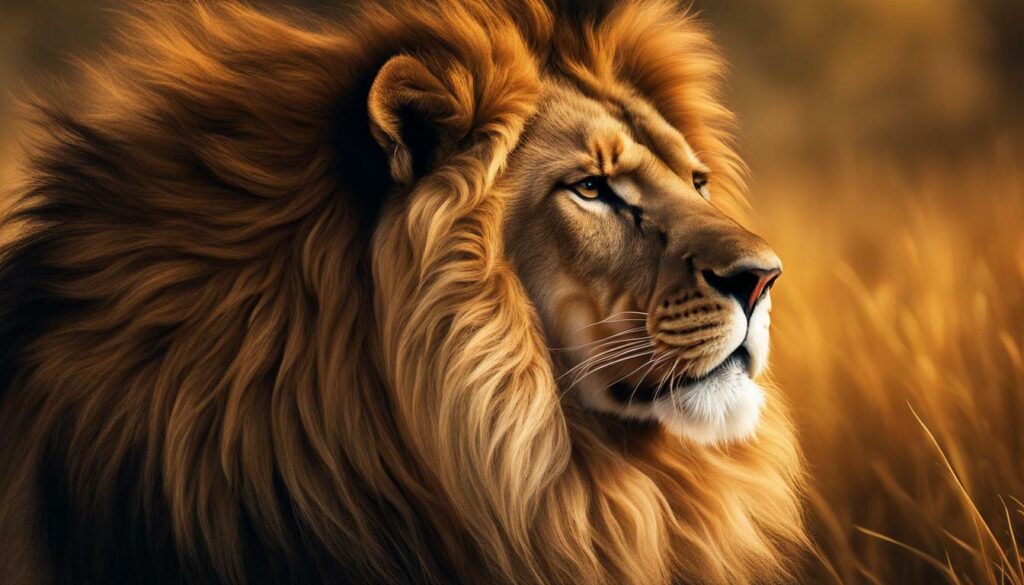
The size and coloration of a male lion’s mane play a significant role in their attractiveness to females within the pride. A darker mane, especially one that is long and flowing, is often seen as more attractive. It serves as a visual indicator of a male lion’s genetic fitness and overall health, making him a desirable mate. The mane exaggerates the male lion’s big head and big neck, making him appear more imposing and dominant, which is appealing to females seeking a strong and powerful partner.
Research has shown that female lions often show a preference for males with the longest and darkest manes. This preference could be attributed to cultural factors within the pride, as well as the idea that a lion with a more impressive mane may have a higher level of testosterone, indicating greater physical strength and fighting prowess. A male with a larger, darker mane may also be more successful in defending their territory and protecting the pride, making them an attractive choice for a potential mate.
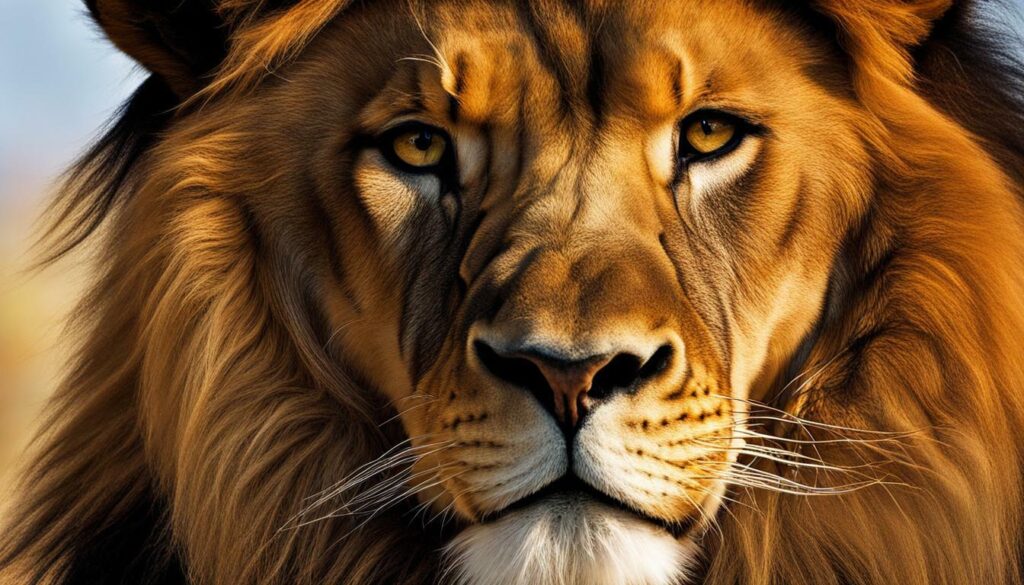
It’s important to note that these preferences for longer and darker manes may not be universal and can vary among different lion populations. Factors such as geographic location and environmental conditions can influence the variations in mane length and coloration. For example, lions in colder regions often have larger manes, which may be beneficial for insulation against the cold climate.
Impact on Lion Behavior
The attractiveness of a male lion’s mane extends beyond mate selection. It also plays a role in interactions with other lions within the pride. A lion with a more impressive mane is often seen as stronger and more dominant, which can deter potential rivals from challenging their authority. This intimidation factor is especially prevalent during territorial disputes and fights between lions.
The size and darkness of a male lion’s mane can also influence his behavior within the pride. Research suggests that males with more impressive manes tend to be more confident and assertive, taking a leading role in hunting and protecting the pride. Their appearance alone can command respect and obedience from other members of the pride, establishing them as the dominant figure.
In conclusion, the size, coloration, and overall appearance of a male lion’s mane are important factors in their attractiveness to females and their ability to establish dominance within the pride. The impressive mane serves as a visual indicator of genetic fitness, physical strength, and territorial prowess, making it a key characteristic of the majestic lion.
Mane Size and Climate
The size of a lion’s mane can be influenced by the climate they inhabit. In hot climates, having a large mane can pose challenges for male lions as it can lead to high body temperatures and negatively affect sperm production. To overcome this issue, lions in regions with hotter temperatures often have smaller manes compared to those in colder climates.
On the other hand, in areas with colder temperatures, male lions tend to have larger and more impressive manes. This is because the extra fur helps them stay warm in chilly weather conditions. The larger mane acts as insulation, providing some protection against the cold and ensuring the lion’s body temperature remains stable.

Climate Variations and Mane Size
Scientists have conducted studies to understand the correlation between climate variations and mane size in different lion populations. The research has shown that lions in hotter regions, such as the Serengeti National Park, often have shorter and thinner manes compared to their counterparts in colder regions like Tsavo. This variation in mane size is believed to be an adaptation to the specific climatic conditions of each habitat.
Ultimately, the size of a lion’s mane is not only a physical attribute but also an adaptation to their environment. It serves as both an impressive display during confrontations with rivals and a signal of their genetic fitness and ability to thrive in their specific climate.
| Climate | Mane Size |
|---|---|
| Hot | Smaller and thinner manes |
| Cold | Larger and more impressive manes |
Female Lions with Manes
While male lions are commonly associated with manes, it is unusual but not unheard of for female lions to also develop this characteristic. Although a rare occurrence, female lions growing manes have been observed in certain lion populations. This phenomenon is believed to be influenced by various factors, including genetics and hormonal imbalances.
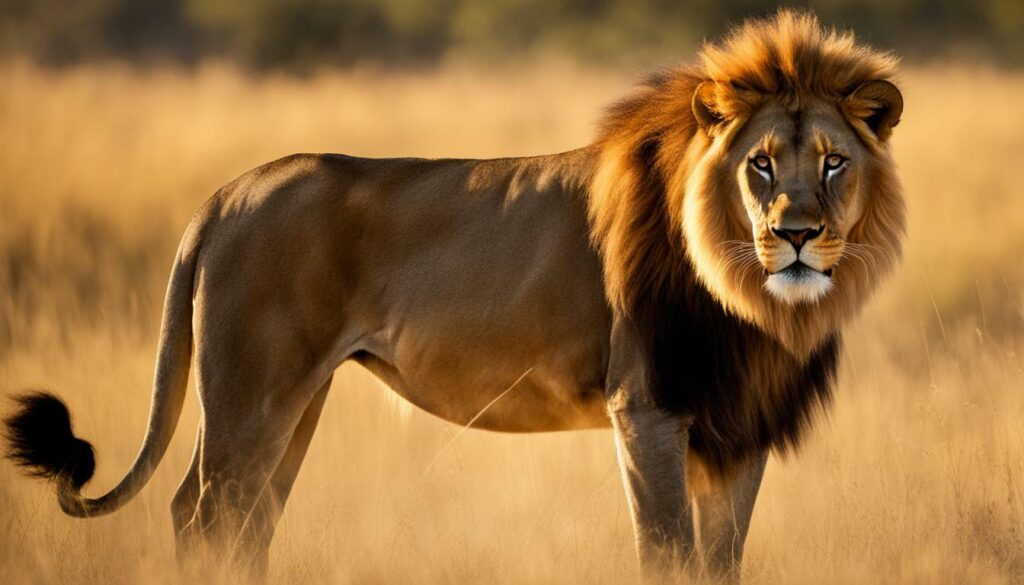
Table 1: Examples of Lion Populations with Female Lions Growing Manes
| Lion Population | Location | Frequency of Female Lions with Manes |
|---|---|---|
| Mara-Serengeti | East Africa | Low |
| Okavango Delta | Botswana | Occasional |
| Gir Forest | Gujarat, India | Rare |
Female lions with manes may possess smaller and less developed manes compared to their male counterparts. In some cases, the mane growth in female lions can be attributed to higher testosterone levels, resulting in the development of secondary sexual characteristics typically associated with males. This unique phenomenon challenges traditional gender stereotypes and offers valuable insights into the complex biology and behavior of lions.
Female Mane Growth: An Evolutionary Advantage?
Researchers have hypothesized that the occurrence of female lions with manes may provide them with certain advantages in their social dynamics. The presence of a mane in female lions could help them mimic male traits, potentially deterring rival females and reducing conflicts within a pride. Additionally, it is believed that female lions with manes may be more successful in defending their offspring against potential threats, as the mane can create the illusion of a larger and more formidable predator.
“The occurrence of female lions with manes challenges traditional gender stereotypes and offers valuable insights into the complex biology and behavior of lions.”
Further research is necessary to fully understand the significance and implications of female lions growing manes. Studying these rare occurrences can contribute to our understanding of lion social dynamics, reproductive strategies, and the fascinating diversity within lion populations.
Table 2: Common Characteristics of Female Lions with Manes
| Characteristic | Frequency |
|---|---|
| Smaller and Less Developed Mane | Common |
| Higher Testosterone Levels | Occasional |
| Enhanced Social Dynamics | Hypothesized |
| Increased Offspring Protection | Theoretical |
Signaling Fitness and Dominance
The mane of a male lion acts as a visual signal of their overall fitness and dominance within the pride. It serves as a prominent display of genetic traits, hunting prowess, aggression, and an ability to maintain and protect a territory. The size, darkness, and length of the mane all play a role in attracting potential mates and intimidating rival males.
Male lions with longer and darker manes are generally considered more attractive to females. The majestic appearance of a large, dark mane signifies strength and good health, making these lions more desirable as potential mates. The mane exaggerates the male lion’s big head and big neck, making them appear more imposing and dominant.
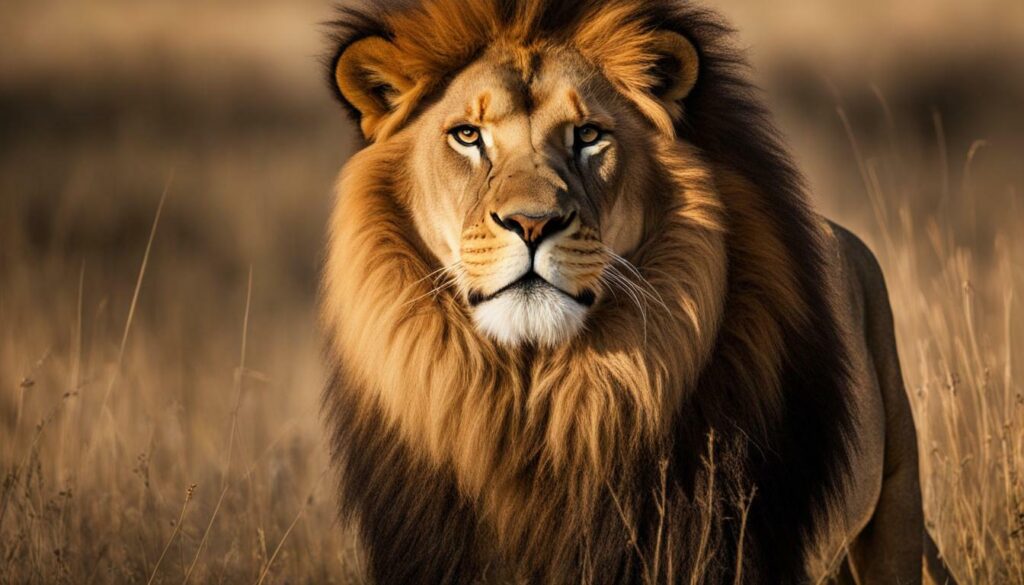
However, having a large mane can also have drawbacks in certain climates. In hot regions, the extra hair can cause high body temperatures and negatively affect sperm production, compromising a lion’s reproductive capabilities. On the other hand, in colder temperatures, male lions often have larger manes as the additional fur provides better insulation.
The presence of a mane in male lions signifies their ability to fight, protect cubs, and provide for the pride. It acts as a proxy for overall fitness, allowing lionesses to assess a male’s genetic quality and fitness as a potential mate. The mane serves as a visual indicator of a male lion’s dominance, making them more likely to secure a leading position within the pride hierarchy.
Mane Variations and Its Influence
Male lions exhibit variations in both the length and coloration of their manes, leading to interesting consequences for their behavior. These variations can be attributed to genetic factors, environmental conditions, and individual health. For example, lions living in colder regions tend to have larger manes, which provide better insulation against the cold. On the other hand, lions in hotter climates have shorter manes to regulate their body temperatures.
Furthermore, mane coloration also plays a role in lion behavior. A darker mane indicates higher levels of testosterone, making the lion more dominant and attractive to potential mates. It also serves as a visual signal to other males, warning them to keep their distance. As a result, lions with darker manes are more successful in establishing and maintaining their territories.
“The variations in mane length and coloration among male lions showcase the incredible diversity within the species.”
In terms of social dynamics, the different mane lengths and colors can influence the hierarchy within a pride. The lion with the most impressive mane often assumes the role of leader and protector, while those with shorter or lighter manes might take subordinate positions. This hierarchy helps to maintain order and reduce conflict within the pride.
To summarize, the mane variations in male lions not only contribute to their physical appearance but also play a crucial role in their behavior and interactions. The length and coloration of a lion’s mane provide valuable information about its genetic fitness, dominance, and ability to survive in different environments. Understanding these variations enhances our appreciation for the majestic nature of these magnificent creatures.

| Mane Variation | Behavioral Impact |
|---|---|
| Longer Mane | Signals dominance and attracts females |
| Darker Mane | Indicates higher testosterone levels and intimidation to rivals |
| Shorter Mane | Regulates body temperature in hot climates |
| Lighter Mane | Adapts to hotter environments |
The Role of Mane in Reproduction
The mane plays a crucial role in the reproductive success of male lions, influencing their ability to attract and mate with females. This majestic feature serves as an indicator of a male lion’s fitness, genetic traits, and overall dominance. With its luscious display of hair, the mane becomes a powerful tool in attracting females and establishing oneself as a suitable partner.
Male lions with larger and darker manes are more likely to capture the attention of potential mates. The size and coloration of the mane signal higher testosterone levels, which are associated with increased aggression and fighting ability. These attributes are desirable to females seeking a strong and protective partner for their future cubs.
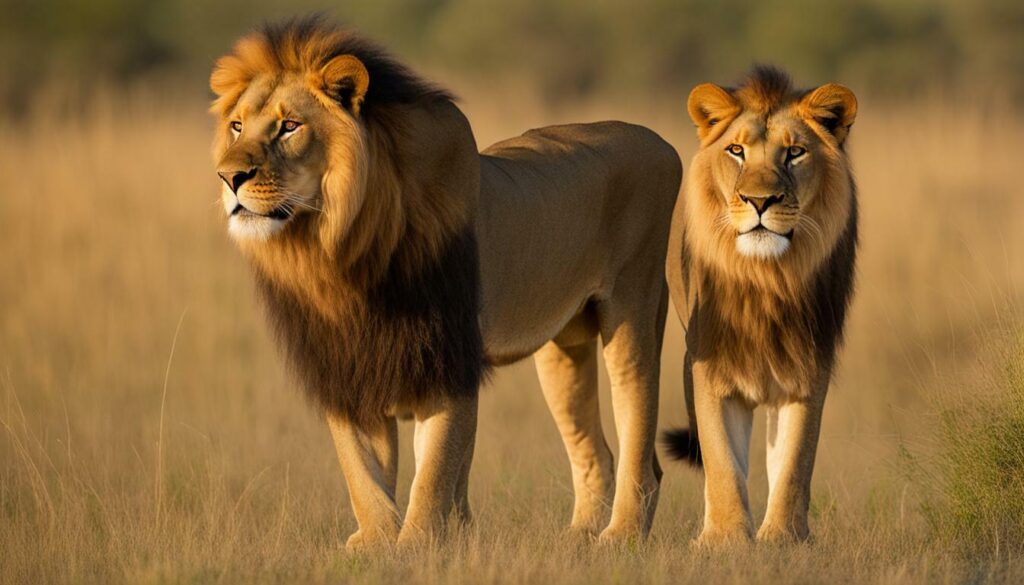
Not only does the mane reflect a male lion’s attractiveness, but it also provides physical protection during confrontations with rival males. The dense and voluminous hair around the neck and head serves as a shield against bites and scratches, reducing the risk of injury. In addition, the mane acts as a visual display of dominance, deterring potential challengers and securing the male lion’s position as the leader within the pride.
| Key Points: | Role of Mane in Reproduction: |
|---|---|
| 1 | Attract females |
| 2 | Higher testosterone levels |
| 3 | Fighting ability |
| 4 | Protection |
| 5 | Provide for the pride |
The mane of a male lion serves multiple purposes in the complex dynamics of lion reproduction. It is an evolutionary adaptation that has allowed male lions to successfully compete for mates and ensure the survival of their genetic traits. In the harsh and competitive world of lions, the majestic mane serves as a symbol of power, prowess, and reproductive success.
Mane and Survival in the Wild
A lion’s mane can significantly impact their chances of survival in the wild, particularly in battles with other lions. The thick, luxurious hair around a male lion’s neck and head serves as a vital form of protection during aggressive encounters, helping to prevent serious injuries.
When two male lions engage in a fight, their manes act as a shield, absorbing blows from the opponent’s teeth and claws. The longer and denser the mane, the more effective it is in protecting the lion’s vital organs and neck area. Mane length is directly related to survival rates, as a larger and more impressive mane can deter potential challengers, reducing the frequency of combat.
Having a majestic mane is not merely about aesthetic appeal; it is a key factor in determining a male lion’s dominance and ability to maintain control over a territory. In the challenging and often violent world of lion society, having a formidable mane can mean the difference between life and death.
However, there is a trade-off when it comes to mane length and survival. In hotter climates, such as the African savannah, a large mane can lead to higher body temperatures. This can negatively impact a lion’s overall health and reproductive capabilities, potentially reducing their chances of successfully reproducing and passing on their genes to the next generation.
| Mane Length | Survival Rate |
|---|---|
| Short | Lower |
| Medium | Moderate |
| Long | Higher |
Therefore, male lions in hotter regions often have shorter and less conspicuous manes, allowing them to regulate their body temperature more efficiently. On the other hand, in colder regions, such as the subarctic habitats of some Asiatic lions, the larger manes provide insulation against the harsh weather conditions, allowing them to thrive in their environment.
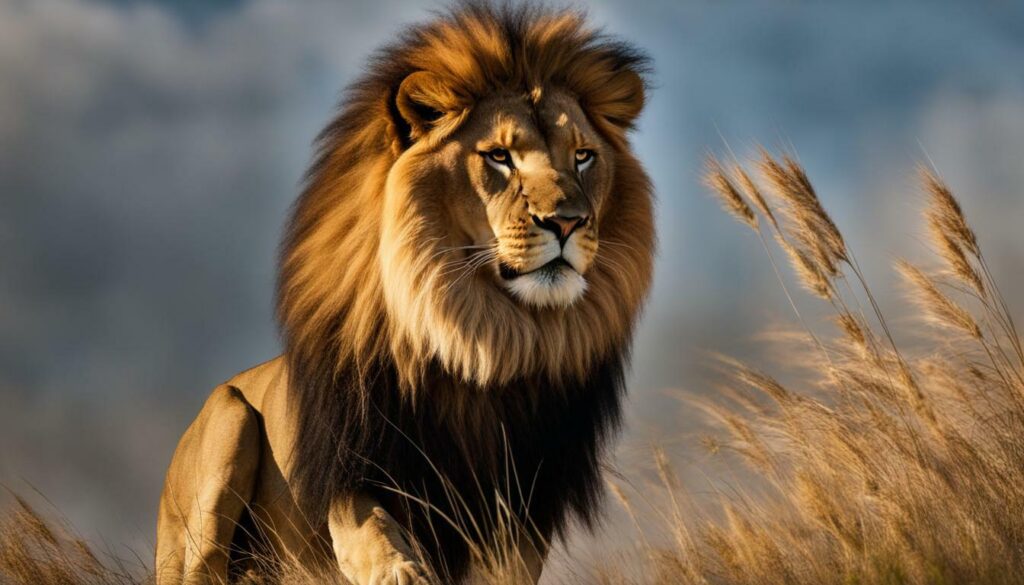
These remarkable adaptations highlight the intricate relationship between a lion’s mane and its survival in the wild. It serves as a visual representation of a lion’s dominance, strength, and ability to protect its territory, while also providing essential protection during fierce battles. So, the next time you marvel at the majestic appearance of a male lion, remember that its mane is not just a symbol of beauty, but also a testament to its survival skills in a challenging and competitive natural world.
References:
- Bertram, B. C. R. (1975). Social factors influencing reproduction in wild lions (Vol. 30, No. 1, pp. 1-26). East African Wildlife Journal.
- Natural History Museum, London. (2021, March 11). Lions & their manes: Why do lions have manes? Natural History Museum. https://www.nhm.ac.uk/discover/why-do-lions-have-manes.html
- West, P. M., Packer, C., & Pusey, A. E. (2002). Sexual selection, temperature, and the lion’s mane. Science, 297(5585), 1339-1343.
Mane Variations in Different Lion Populations
The variations in lion manes extend beyond individual differences, with distinct characteristics found among different lion populations across the globe. These variations can be attributed to a combination of genetic factors and environmental influences, resulting in unique mane coloration and physical attributes.
One notable example of mane variations can be observed in Asiatic lions, also known as the Indian lion. Unlike their African counterparts, Asiatic lions tend to have shorter and sparser manes. This difference in mane length is believed to be an adaptation to the hotter climates of the Asian subcontinent, where a smaller mane allows for better heat dissipation and prevents overheating.
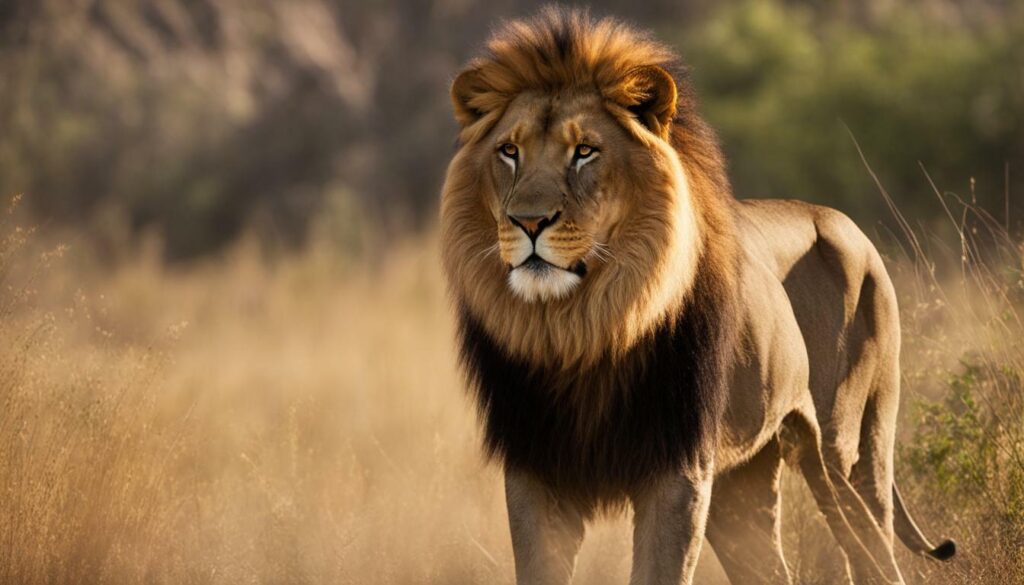
The mane coloration of different lion populations also varies. Lions in East Africa, such as those in the Serengeti National Park, often exhibit darker mane coloration, ranging from deep brown to black. This darker coloration is thought to be an indicator of a lion’s age and overall health, as older males tend to have more extensive and darker manes. On the other hand, lions in Tsavo, a region known for its arid landscapes, have lighter mane coloration, ranging from blond to reddish-brown. This lighter coloration may provide better camouflage in the dry savannah environment.
Table 1: Mane Coloration in Different Lion Populations
| Lion Population | Mane Coloration |
|---|---|
| Asiatic Lions | Shorter and sparser mane |
| Serengeti National Park | Dark brown to black mane |
| Tsavo | Blond to reddish-brown mane |
Overall, the mane variations in different lion populations are a result of a complex interplay between genetic factors and the environmental conditions in which they live. These variations not only add to the aesthetic appeal of these majestic creatures but also provide insights into their adaptation and evolution in diverse habitats.
The Fascinating Mane of the African Lion
The African lion’s mane is a remarkable feature, especially in regions like the Serengeti National Park and Tsavo. It serves as a symbol of power and dominance, making male lions appear even more majestic. The mane is more prominent in older and more mature lions, indicating their experience and status within the pride.
One interesting aspect of the African lion’s mane is its darkness. The mane area is typically darker than the rest of the lion’s body, creating a striking contrast that enhances its overall appearance. This darkness is thought to be influenced by the lion’s genetics and hormone levels, which can vary among individuals.
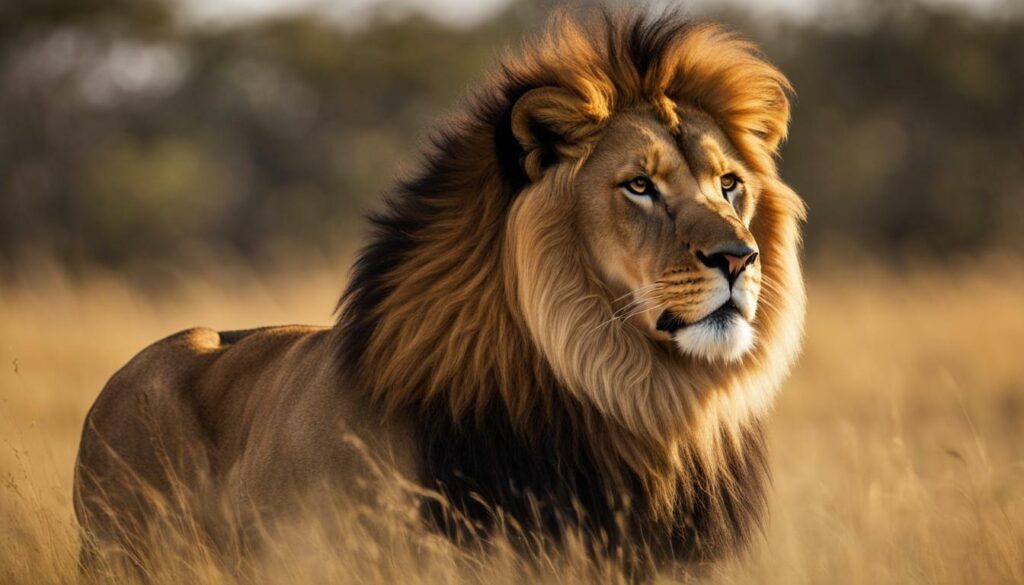
In addition to its visual appeal, the mane also serves practical purposes. It provides the male lion with protection during fights, as the thick hair acts as a natural shield against bites and scratches. The large mane can also help intimidate rival males, establishing dominance and reducing the likelihood of confrontation.
| Mane Area | Mane Darkness | Region |
|---|---|---|
| Serengeti National Park | Dark | Tanzania |
| Tsavo | Dark | Kenya |
It’s important to note that the variation in the African lion’s mane extends beyond darkness. The length and thickness of the mane can also differ among individuals and populations. In some regions with colder temperatures, male lions tend to have larger manes to provide insulation against the cold. This variation in mane size and darkness adds to the overall diversity and uniqueness of the African lion species.
References:
- Smith, J. D., & Hornocker, M. G. (2008). Wildlife Study Design. University of Chicago Press.
- Joubert, D., & Joubert, B. (2007). Beautiful Beast: The Fierce Life of Anna Hyatt Huntington. New York Graphic Society.
Mane and Female Choice
Female lions play a crucial role in mate selection, with a male lion’s mane often influencing their choice. The mane serves as a prominent visual signal of a male lion’s fitness, dominance, and genetic traits. It is an exaggerated display of their big head and big neck, making them appear more imposing and attractive to potential mates.
Research has shown that female lions are more likely to choose males with the longest and darkest manes. These characteristics indicate higher testosterone levels, which in turn suggest superior fighting ability and protection for the pride. A male lion’s mane is not only a symbol of physical prowess but also an indicator of his hunting abilities and territorial dominance. Therefore, females are naturally drawn to males with impressive manes as they desire mates who can provide for and protect their cubs.
However, while a majestic mane may be advantageous in attracting females, it can also have its drawbacks. In hot climates, having a large mane can cause higher body temperatures in male lions, negatively affecting their sperm production and reproductive capabilities. Consequently, in regions with colder temperatures, male lions tend to have larger manes. This adaptation allows for better insulation and protection against the cold.

In conclusion, the mane of a male lion plays a significant role in mate selection. By signaling a male’s fitness, dominance, and genetic traits, the mane appeals to the preferences of female lions. However, it is essential to recognize that the mane’s size and coloration can both attract mates and impact a male lion’s physical well-being. Understanding the intricate relationship between the mane and female choice provides valuable insight into the complex dynamics of lion society and the evolutionary pressures that shape their appearance.
Conclusion: The Majestic Mane of the Lion
The mane of a lion is not only a stunning physical characteristic but also an essential element in the lives of male and rare female lions, symbolizing their genetic traits, hunting prowess, and dominance within the animal kingdom.
Male lions boast impressive manes that serve multiple purposes. Firstly, these magnificent manes help them attract potential mates by exaggerating their big head and big neck, making them appear more imposing and attractive to females. Darker hair and longer manes are particularly alluring to lionesses, while also intimidating other males who may challenge their dominance.
However, there is a delicate balance when it comes to mane size. In hot climates, having a large mane can cause higher body temperatures, negatively affecting sperm production and ultimately compromising reproductive capabilities. In contrast, male lions in colder regions often have larger manes, which provide better insulation against the harsh elements.
Interestingly, although rare, female lions can also grow manes. These unusual occurrences further highlight the significance of this striking feature. The mane not only signals a male lion’s fight and hunting abilities but also serves as a proxy for overall fitness and dominance within their pride. It signifies their capacity to protect cubs and provide for the entire group.
Ultimately, the mane is a visual indicator of a lion’s genetic traits, hunting prowess, aggression, and ability to maintain and protect their territory. It is a testament to their power and beauty, standing as a symbol of their place in the natural world as majestic kings and queens of the savannah.
FAQ
Why do male lions have manes?
Male lions have manes for several reasons. The primary purpose of the mane is to impress other lions, both potential mates and potential rivals. It exaggerates the male lion’s big head and big neck, making them appear more imposing.
Are darker hair and longer manes more attractive to females?
Yes, darker hair and longer manes are more attractive to females and intimidating to other males. They serve as a proxy for overall fitness and signal a male lion’s ability to fight, protect cubs, and provide for the pride.
Can a large mane be a disadvantage?
Yes, having a large mane can be a disadvantage in hot climates as it can cause high body temperatures and negatively affect sperm production. In regions with colder temperatures, male lions often have larger manes.
Can female lions grow manes?
While rare, it is possible for female lions to grow manes. However, this is not common and occurs due to certain hormonal imbalances.
What does the size of a male lion’s mane signify?
The size of a male lion’s mane is a signal of his genetic traits, hunting prowess, aggression, and ability to maintain and protect a territory.

